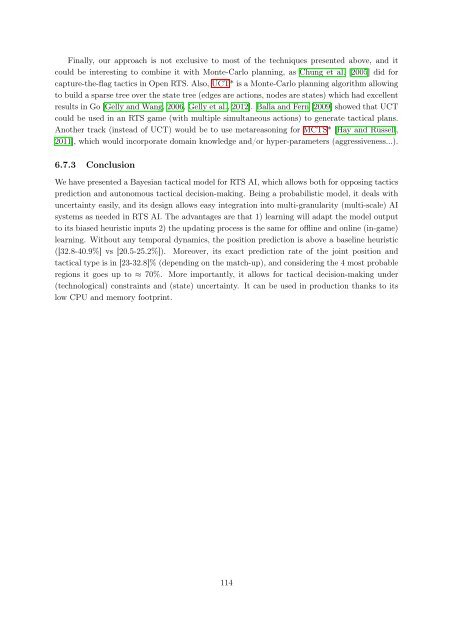Bayesian Programming and Learning for Multi-Player Video Games ...
Bayesian Programming and Learning for Multi-Player Video Games ...
Bayesian Programming and Learning for Multi-Player Video Games ...
Create successful ePaper yourself
Turn your PDF publications into a flip-book with our unique Google optimized e-Paper software.
Finally, our approach is not exclusive to most of the techniques presented above, <strong>and</strong> it<br />
could be interesting to combine it with Monte-Carlo planning, as Chung et al. [2005] did <strong>for</strong><br />
capture-the-flag tactics in Open RTS. Also, UCT* is a Monte-Carlo planning algorithm allowing<br />
to build a sparse tree over the state tree (edges are actions, nodes are states) which had excellent<br />
results in Go [Gelly <strong>and</strong> Wang, 2006, Gelly et al., 2012]. Balla <strong>and</strong> Fern [2009] showed that UCT<br />
could be used in an RTS game (with multiple simultaneous actions) to generate tactical plans.<br />
Another track (instead of UCT) would be to use metareasoning <strong>for</strong> MCTS* [Hay <strong>and</strong> Russell,<br />
2011], which would incorporate domain knowledge <strong>and</strong>/or hyper-parameters (aggressiveness...).<br />
6.7.3 Conclusion<br />
We have presented a <strong>Bayesian</strong> tactical model <strong>for</strong> RTS AI, which allows both <strong>for</strong> opposing tactics<br />
prediction <strong>and</strong> autonomous tactical decision-making. Being a probabilistic model, it deals with<br />
uncertainty easily, <strong>and</strong> its design allows easy integration into multi-granularity (multi-scale) AI<br />
systems as needed in RTS AI. The advantages are that 1) learning will adapt the model output<br />
to its biased heuristic inputs 2) the updating process is the same <strong>for</strong> offline <strong>and</strong> online (in-game)<br />
learning. Without any temporal dynamics, the position prediction is above a baseline heuristic<br />
([32.8-40.9%] vs [20.5-25.2%]). Moreover, its exact prediction rate of the joint position <strong>and</strong><br />
tactical type is in [23-32.8]% (depending on the match-up), <strong>and</strong> considering the 4 most probable<br />
regions it goes up to ≈ 70%. More importantly, it allows <strong>for</strong> tactical decision-making under<br />
(technological) constraints <strong>and</strong> (state) uncertainty. It can be used in production thanks to its<br />
low CPU <strong>and</strong> memory footprint.<br />
114


